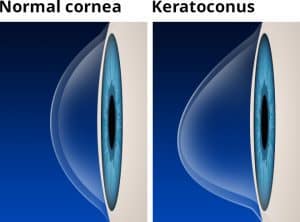FAQs about Keratoconus and Corneal Ectasia
What is Keratoconus?
A type of corneal dystrophy in which the cornea gets progressively thinner. Between five and 14 per cent of those who have the condition have a family history of Keratoconus. It starts with the thinning of the middle of the cornea, then slowly bulges outward to form a rounded cone shape. This produces moderate to severe distortion (astigmatism) and blurriness (nearsightedness) of vision.

Keratoconus
What are other conditions similar to keratoconus?
Disorders in which one or more parts of the cornea lose normal clarity due to a buildup of cloudy material. These diseases are usually inherited, affect both eyes equally, are not caused by outside factors (such as injury or diet), progress slowly and usually occur in otherwise healthy people. Of the more than 20 types, some of the most common corneal dystrophies include Fuchs’ dystrophy, lattice dystrophy and map-dot-fingerprint dystrophy.
What are the main symptoms of keratoconus?
A blurring of vision and frequently changing refraction are chief initial symptoms. However advanced keratoconus may cause pain and tear after hydrops.
What is the Treatment of Keratoconus?
Keratoconus usually affects both eyes. At first, people can correct their vision with eyeglasses. But as astigmatism worsens, they must rely on specially fitted contact lenses to improve vision. Several treatment options are available for persons with keratoconus, including:
Collagen cross-linkage (CXL) is the top of the list in treatments offered to patients with progressive keratoconus.
Spectacle correction/ rigid contact lenses, which can give high-quality vision for many patients for many years with little risk.
INTACS® prescription lenses, which are implanted in the eye.
Corneal transplants, which is the best option for patients who have got central corneal bulge with hydrops. Because the cornea is avascular, this procedure is highly successful (96 to 98 per cent success rate) in keratoconus.
Is there a procedure contraindicated for patients with keratoconus?
Persons who have keratoconus should not be treated with radial keratotomy (RK), astigmatic keratotomy (AK), automated keratomileusis (ALK) or laser in-situ keratomileusis (LASIK), as these surgical procedures will have poor outcomes from persons with keratoconus. All nearsighted patients considering PRK or LASIK should have screening with corneal topography to rule out early forms of keratoconus.

